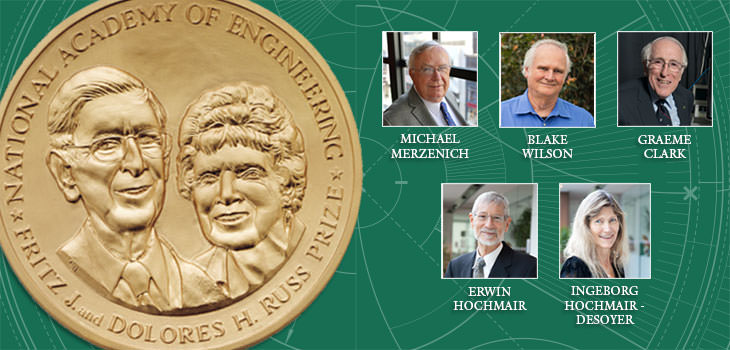2015 Russ Prize
On Feb. 24, 2015, Ohio University and the National Academy of Engineering (NAE) awarded the 2015 Fritz J. and Dolores H. Russ Prize, the bioengineering profession's highest honor, to Blake S. Wilson, Graeme M. Clark, Erwin Hochmair, Ingeborg J. Hochmair-Desoyer and Michael M. Merzenich for engineering cochlear implants that enable the deaf to hear.
Created by Fritz Russ, a 1942 electrical engineering graduate and his wife, Dolores, the Fritz J. and Dolores H. Russ Prize is a $500,000 biennial award recognizing a bioengineering achievement that significantly improves the human condition. The accomplishments of the 2015 recipients have enabled the gift of hearing for hundreds of thousands of individuals.
“This year’s Russ Prize recipients personify how engineering transforms the health and happiness of people across the globe,” said NAE President C.D. Mote, Jr. “The creators of the cochlear implant have improved remarkably the lives of people everywhere who are hearing impaired.”
Dennis Irwin, dean of Ohio University’s Russ College of Engineering and Technology, which named for the Russes in 1994, said the award supports the Russes’ vision of creating a prize to honor achievements that change lives.
“I am very, very pleased that the cochlear implant has been recognized as a significant advancement that contributes positively to the quality of life of those with hearing impairment,” Irwin said. “I have had the privilege of knowing and working with several individuals with profound hearing loss throughout my early life and later career, and I witnessed the difficulty several of them faced in athletic pursuits, education and their careers,” he added.
Cochlear implants (CIs) are small electronic devices that provide people with severe-to-profound sensorineural hearing loss, with a sense of sound. CIs comprise two parts: an externally-worn audio processor, which picks up sound and codes it into signals, transmitted to the small, surgically-implanted internal component. An electrode attached to the implant directly simulates the auditory nerve and sends the signal to the brain where it is interpreted as sound. The CI is the most-used neural prosthesis developed to date; more than 320,000 hearing-impaired people have received CIs in one or both ears.
Michael M. Merzenich, a neuroscientist and professor of otolayrnology at the University of California at San Francisco (UCSF), established some of the neurophysiological underpinnings of present CI designs in 1971. Best known for his ground-breaking discoveries in multisite stimulation of CIs and neuroplasticity, Merzenich, along with other CI contributors, paved the way to the Advanced Bionics cochlear prosthesis, which enabled greater access to and commercialization of CIs.
Electrical engineers Ingeborg J. Hochmair-Desoyer and Erwin Hochmair, co-founders of the leading global hearing implant manufacturer MED-EL Medical Electronics, GmBH, began their work on CIs as a team in the mid-1970s. Building on existing knowledge of the physiology of the auditory system, their engineering-based approach led to the world’s first microelectronic multichannel CI, considered to be the prototype of modern CIs. The first two devices were implanted in December of 1977 and in March of 1978. Open speech understanding, without lip reading via a small body-worn audio processor, was achieved in 1980. The Hochmairs went on to found MED-EL and have continued to bring cutting-edge hearing implant technologies to deaf and severely hearing impaired people of all ages for the past 25 years.
At the same time, physician Graeme Clark, professor of otolaryngology at the University of Melbourne, was independently studying multi-site stimulation of the cochlea through the “place coding” phenomenon, which routed particular speech sounds to different parts of the cochlea. Clark was focused on designing an implant that would sit flawlessly against the cochlea to correctly stimulate nerve endings. He perfected his design in 1978, and not long after, he implanted his CI into a patient. This enabled Clark to discover how to select the best speech information for deaf adults and children, and later, in 1989, how bilateral implants could assist hearing speech in noise. He helped create global leader Cochlear Limited, which has over 30 years provided implants to more than 250,000 patients.
In the late 1980s, engineer Blake S. Wilson, an adjunct professor in Duke University’s departments of surgery, biomedical engineering, and electrical and computer engineering, and co-director of the Duke Hearing Center, developed the “continuous interleaved sampling” system. This model made it possible for CI recipients to understand words and sentences with far greater clarity than before. Wilson’s breakthrough provided the basis for sound-processing strategies used widely in today’s CIs and resulted in a rapid expansion in the number of deaf and nearly deaf persons who have received a cochlear implant in one or both ears.
“The culmination of bioengineering advances by this year’s Fritz J. and Dolores H. Russ Prize winners has vastly improved the quality of life for people with hearing loss, and Ohio University is proud to recognize their achievement in partnership with the National Academy of Engineering (NAE),” said Ohio University President Roderick J. McDavis. “Cochlear implants are a wonderful testament to the ways in which engineering achievements are improving the human condition. We are proud to steward the vision of Fritz and Dolores Russ through this extraordinary award.”
Clark, the Hochmairs, Merzenich, and Wilson are the eighth recipients of the Russ Prize.
